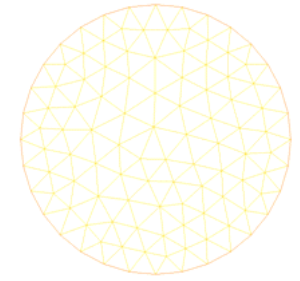11. Modeling I#
11.1. Characteristics of modeling#
2 POU_D_TGM elements per section type. There are therefore 2 groups of elements each comprising 2 elements.
Group |
\(\mathrm{GR1}\): |
rectangular section |
\(\mathrm{GC1}\): |
circular section |
|
Simple traction with work hardening |
on \(\mathrm{GR1}\) and \(\mathrm{GC1}\) (ECRO_LINE) |
|
Pure bending without work hardening |
on \(\mathrm{GR1}\) and \(\mathrm{GC1}\) without work hardening |
|
11.2. Characteristics of the mesh#
Beam mesh
\(2\times 2\) elements POU_D_TGM
Meshing the sections

111 knots, 188 TRIA3 |

231 knots, 200 QUAD4 |
11.3. note#
The particularity of modeling \(L\) is to test the functioning of DYNA_NON_LINE in the calculation of the quasistatic traction of a beam modeled in POU_D_TGM. The particularity of this type of modeling is that it reveals zero pivots on the rows of the mass matrix corresponding to the degrees of freedom of warping. In this case, the initialization of the NEWMARK diagram is no longer done by inverting the mass matrix, which is singular, but by setting the initial acceleration to zero.
11.4. Tested sizes and results#
11.4.1. Tested values#
Single pull (with \({\mathrm{DX}}^{e}=0.75E-03\))
\({\mathrm{DX}}_{(B)}\) |
Order Number |
GROUP_MA |
NOEUD |
Identification |
Reference Type |
Reference |
Tolerance |
|
\(2{\mathrm{DX}}^{e}\) |
11 |
GR1 |
R3 |
EFGE_ELNO |
N |
ANALYTIQUE |
\(3.E+06\) |
\(0.10\text{\%}\) |
\(3{\mathrm{DX}}^{e}\) |
21 |
GR1 |
R3 |
EFGE_ELNO |
N |
ANALYTIQUE |
\(3.E+06\) |
\(0.10\text{\%}\) |
\(2{\mathrm{DX}}^{e}\) |
11 |
GC1 |
C3 |
EFGE_ELNO |
N |
ANALYTIQUE |
\(4.82E+06\) |
\(2.5\text{\%}\) |
\(3{\mathrm{DX}}^{e}\) |
21 |
GC1 |
C3 |
EFGE_ELNO |
N |
ANALYTIQUE |
\(4.87E+06\) |
\(2.5\text{\%}\) |
\(3{\mathrm{DX}}^{e}\) |
21 |
GC1 |
C3 |
DEGE_ELNO |
EPXX |
ANALYTIQUE |
\(2.25E\mathrm{-}03\) |
\(0.10\text{\%}\) |
\({\mathrm{DX}}_{(B)}\) |
Order Number |
MAILLE |
Point |
Sub-point |
Identification |
Reference Type |
Reference |
Tolerance |
|
\(3{\mathrm{DX}}^{e}\) |
21 |
GR1 |
1 |
1 |
VARI_ELGA |
V1 |
ANALYTIQUE |
\(1.5E\mathrm{-}03\) |
\(20.0\text{\%}\) |
\(3{\mathrm{DX}}^{e}\) |
21 |
GC1 |
1 |
1 |
VARI_ELGA |
V1 |
ANALYTIQUE |
\(1.5E\mathrm{-}03\) |
\(1.5\text{\%}\) |
11.4.2. Observations#
Note that the traction results from DYNA_NON_LINE are identical to those given by STAT_NON_LINE.